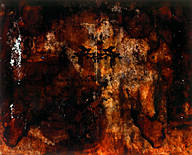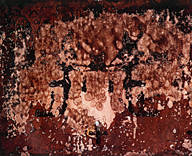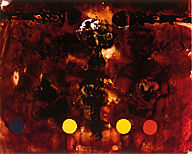

By Jón Proppé
When Gudjón Bjarnason had his first large-scale show in Iceland the works seemed to exude and architectural mysticism - an impression we now suspect was largely conditioned by the knowledge of his background in architecture. Nonetheless these works were executed on such a scale that they seemed to merge into some unified structure or environment - large paintings or mosaic arrangements of smaller ones that together enveloped the visitor to the exhibition, providing a horizon of dark and impenetrable landscapes.
The method used in these paintings seems best described as accretion, both as regards the actual surface and the glimpse of representation that they offered. Perhaps at root constructivist, the paintings had acquired layers of dark or gleaming material, often resembling industrial grime or the accretion of organic and mineral matter that can render newly discovered artefacts of antiquity virtually indistinguishable from the ground they are dug out of. The images that we glimpsed through the surface were vague indications of depth with perspectives and extensions that seemed to have altered and deepened with each layer that was applied to the surface. The effect was a mesmerising contradiction where the viewer was given a hint of vast spaces in the painting’s interior, but with a clear indication that these would not be inhabitable spaces - that they were somehow tainted and would not support life, not even the life of the imagination.
When Gudjón Bjarnason turned to sculpture his method had altered. The sculptures were simple, angular structures of steel and the emphasis was no longer on the interior space but rather on the placement of the work itself in space. The sculptures did not promise an alternative landscape for us to explore, but offered the possibility of engaging our own spaces, reordering their dynamics and rendering simple forms and tangents significant in a way that had not seemed possible before. By combining simple large-scale structures that resembled signs written in three dimensions with more intricate patterns that pierced the steel, Gudjón managed to invest his almost minimalist sculptures with a baroque sensibility. Instead of being closed to signification - like so many minimalist works are - they seemed to offer an ornate three-dimensional alphabet that could be expanded to fill any space with meaning.
In his latest paintings Gudjón has approached a purer sense of representation and has in effect merged the primary features of the two earlier phases of the first show and the later sculptures. Horizons now appear in indistinct landscapes to bring shadow and light into line with an ordering principle. Though his working method still involves layering, the intention is very different from that of his earlier paintings: Instead of forming accretions the layers are atmospheric and one has a clear impression that the spaces represented here are not interior spaces but limitless expanses, though still unfamiliar and forbidding. That these landscapes are obscure, dark and impenetrable is consistent with the artist’s continuing occupation with space. As the earlier paintings underlined the impossibility of escaping into alternative spaces, so the sculptures urged the need to reorder and reinhabit our world. These latest paintings offer no pat solutions. On the contrary, they seem to show - through their refusal to make the represented landscapes accessible by the addition of detail - how far we still are from finding such a solution, if a solution is at all possible.
The critical spirit implied by these works extends to the problem of representation and to the representational status of the painting itself. Representation is at once easy and impossible. Our visual vocabularies are repositories of easily recognised images that can be evoked almost without effort. A simple line drawn across a surface from side to side readily evokes a horizon as a few meandering marks on paper can evoke a face. As soon as such a hint is detected a painting ceases to be only an object among other objects but becomes instead a window onto another world. That represented world captures our attention and it requires and effort for the viewer to regain a critical attitude, somewhat as it requires effort on the part of a proofreader not to allow his attention to style, spelling and punctuation to be distracted by the sense of what he reads.
Mere representation can never be the aim of a painting and in an important sense representation could be seen as an enemy to art, a distraction from the primary aesthetic business at hand. The represented world within the work is not the world of the work itself and must never overwhelm the viewer. Gudjón’s paintings show an awareness of this problematic and he constantly disrupts the representational elements in his works, calling the viewer back to attention and forcing him to approach the painting on its own terms.
Despite this problematic the paintings are indeed echoes of a landscape and they extend Gudjón’s concern with spaces into the realm of nature. Not, of course, that Gudjón intends any particular landscape to echo in these pictures. Rather they take as their aim landscapes in general and the focus is always on the formal and aesthetic aspects of the paintings themselves - they are ‘nature-made-theatre’ where the artist can use the sublime effects of such a representation to lend force to his own arguments and investigations. But the formal and aesthetic concerns that occupy him in painting can also illuminate our experience of nature itself to some degree and it is difficult to overlook the presence of the raw and forbidding landscape of Iceland in these paintings. The violence that we see in the paintings also brings to mind the violence that is being applied to the actual landscape; violence that is the mark of man’s presence in the landscape. Open cast mines pit the mountains and roads run like scars along the hillsides, and these intrusions mirror the problems that we encounter in painting a landscape, though in such cases the intrusion is not physical but instead involves the viewer and the artist in an intellectual sense.
There is a clear progression in Gudjón’s ongoing critique of spaces. The conceptual framework that he brings to his work includes a profound distrust of traditional modes of representations and of the assumptions that most often rule the production of art and our acceptance of it. His work is informed by an awareness of the breakdown of ideological systems - what Lyotard has called ‘the grand narratives’ - and of the elusiveness of concrete understanding and form. In the words of Paul Virilio ‘we have gone from the aesthetic of appearance, stable forms, to the aesthetic of disappearance, unstable forms.’
Jón Proppé works in Reykjavík, writing and lecturing on art and philosophy. He is a regular rewiever for the Reykjavík daily newspaper Morgunbladid and is chief editor of art.is. This text was printed in the catalogue for Gudjón Bjarnason’s exhibition in Hafnarborg, the Hafnarfjördur Institute of culture and Fine Art, in 1992.
Text © Jón Proppé
Artwork © Gudjón Bjarnason

Oil and mixed media on paper, 41 x 51 cm

Oil and mixed media on paper, 41 x 51 cm

Oil and mixed media on paper, 41 x 51 cm
|
|
|
|
|
|
|
|